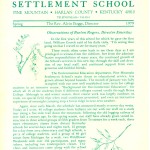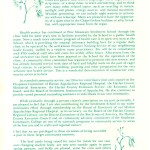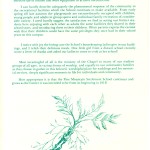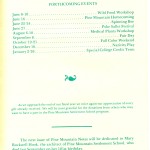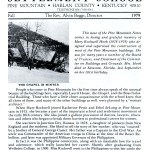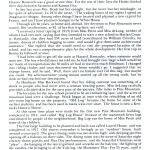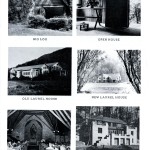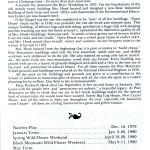Pine Mountain Settlement School
Series 17: PUBLICATIONS PMSS
NOTES 1979
Spring and Fall
℘ IN MEMORIAM ℘
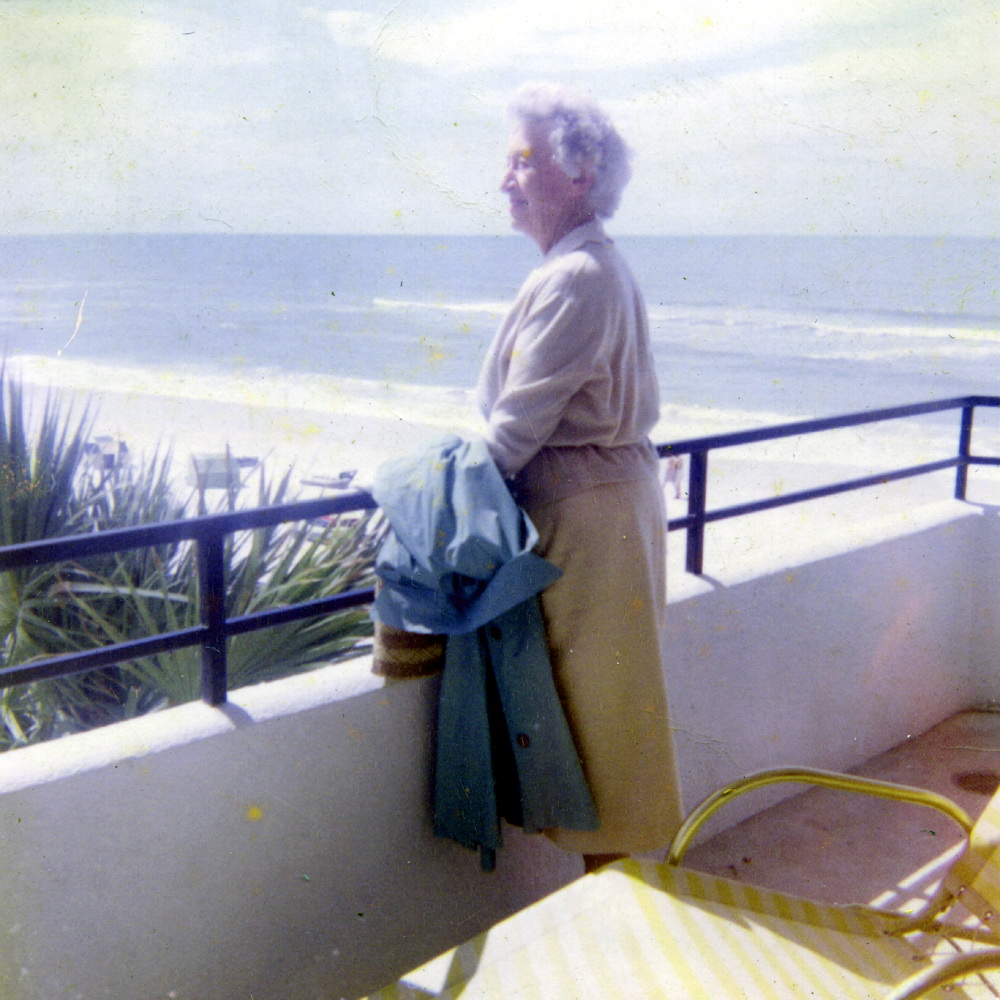
Mary Rockwell Hook in Florida, c. 1935. [X_099_workers_2466b_mod.jpg]
NOTES – 1979
“Notes from the Pine Mountain Settlement School”
Spring & Fall 1979
GALLERY: NOTES – Spring 1979
I can hardly describe adequately the phenomenal response of the community to the recreational facilities which the School continues to make available. – Burton Rogers
- NOTES – 1979 Spring, page 1. [PMSS_notes_1979_spr_001.jpg]
- NOTES – 1979 Spring, page 2. [PMSS_notes_1979_spr_002.jpg]
- NOTES – 1979 Spring, page 3. [PMSS_notes_1979_spr_003.jpg]
- NOTES – 1979 Spring, page 4. [PMSS_notes_1979_spr_004.jpg]
TAGS: Notes – 1979 spring, Burton Rogers, Environmental Education, college courses, school groups, curriculum, astronomy, medical service, clinics, Frontier Nursing Service, Infirmary, nurse, community clinic committee, community service, cattle, sheep, Spinning Bee, bathhouse, playground, Chapel, drawings, fundraising
TRANSCRIPTION: NOTES – 1979 Spring
P. 1
NOTES FROM THE
PINE MOUNTAIN
SETTLEMENT SCHOOL
PINE MOUNTAIN * HARLAN COUNTY * KENTUCKY 40810
TELEPHONE 606 / 558-4361
Spring The Rev. Alvin Boggs, Director 1979
[Image: Drawing of a branch with leaves and flowers.]
Observations of Burton Rogers, Director Emeritus
In the first years of this school for which he gave the first land, William Creech said of his daily visits, “I’m seeing that going on that I craved to see for many years.”
These words often come back to me these days as I am privileged to witness from the sidelines, free from the administrative responsibilities of many years, the continued growth of the School’s services in this new day through the skill and devotion of our loyal staff, and continued support from ever-generous and faithful friends.
The Environmental Education department, Pine Mountain Settlement School’s main thrust in educational service, has grown almost beyond bounds. The month of January was fully occupied with our now well established inter-term for college students in an intensive course, “Background for Environmental Education”, for which all 15 of the students from 6 different colleges earned credit through Berea College. Although in mid-winter season, their course work was largely outdoors on trails, on special field trips when road conditions permitted, and even an instructive experience of overnight camping atop a forest ridge in near-zero weather.
Again, since early March, the schedule has amounted mostly to seven-day weeks. Today as I write, 40 college students from Indiana are out with our staff on a study tour along a five-mile trail down the mountain, following the old logging railway of over half a century ago. In this spring season, our staff have already given varied instruction to three school groups of fifth-graders from Tennessee for a week each, three more elementary classes from distant Kentucky schools for several days and nights each, 12 groups for a day from area elementary and high schools, a party of college students, and a group of 40 girl scouts from Michigan for a week, two Wildflower Weekends with over 150 participants, and many others, including two kindergarten classes. Teachers and instructors come along with the school and college sessions. Several church or religious groups, including families, have come for weekend retreats, wishing to include in their purpose some experience in fuller understanding and deeper appreciation of the environment.
[Image: Drawing of a branch with leaves and flowers.]
P. 2
[Image: Drawing of a branch with leaves and flowers.]
Some friends ask what makes up the general curriculum. It includes studies of the physical world, water, weather, soil, rocks and studies of the living communities of forest, field and stream, of trees, birds and flowers. It includes appraisal of Indian, pioneer, and modern man’s relationship to their environments. It gives opportunities to explore caves, hike, participate in crafts and games, hear stories, sing songs, visit a virgin forest, a strip mine, or a deep mine, to learn orienteering, and to think over many other related topics, such as recycling in nature, sunlight and plants, energy sources, and natural succession. Weather permitting, we can include night sessions in astronomy with our telescope. Many are pleased to have the opportunity of a quiet time in the Chapel before bedtime or after breakfast, with appropriate music from the organ.
Health service has continued at Pine Mountain Settlement School through the clinic held for some years now in facilities provided by the School to a public health nurse. Now a much more extensive program of health care is to open very soon at the School, which is providing the original infirmary building here for a regular daily clinic to be operated by the well-known Frontier Nursing Service of our neighboring Leslie County, staffed by a resident nurse practitioner. She will be in consultation with FNS medical staff who will come for weekly office hours. Allocations from the coal severance tax fund have been granted to the School for the operation of the clinic. A community clinic committee has organized to promote this new service, and has already donated several work days of hard and helpful work on the part of eager local citizens, in carpentry, furnishing, painting and other preparation for the very welcome new health service. This is a wonderful demonstration of constructive community action at its best.
In extended community service, our Director contributes time and counsel on the Chaplains Committee of Harlan Appalachian Regional Hospital, the Harlan County Ministerial Association, the Harlan County Extension Service, the Economic Aid board, and the Board of Settlement Institutions of Appalachia. He also continues to provide varied personal counseling assistance to individuals in our own community.
While primarily through a private citizen’s association on my part personally, I am pleased to feel that I am also contributing for the Settlement School to our wider community effort through membership on the Board of Governors of our Harlan Appalachian Regional Hospital, as its secretary, on the Board of the Harlan County Regional Library, on the District Committee of the Boy Scouts of America, the Harlan County Extension Council and on community advisory committees of the Southeast Community College on two of its outreach programs in community service in areas of the fine arts and in crafts and regional culture.
I feel that we are privileged in these occasions of being accorded a part in these larger community concerns.
The beef cattle being raised for meat for meals for our vast, ever-changing student body, are now seen outside again in green spring pastures, and fields are plowed, some for corn and others growing their first crop of hay for winter feed. Some of this is shared with the four sheep and five lambs, due to be shorn at next month’s Spinning Bee and well serving these days their purpose of bringing alive to children some basic aspects of previous generations’ adaptation to a wilderness environment. I also observe early vegetables appearing in the School gardens for dining hall use.
[Image: Drawing of a branch with leaves and flowers.]
P. 3
All over the campus I see the same crew of faithful men at work on the upkeep of buildings and grounds so vital to the School’s educational and other services, new windows in the Chapel and elsewhere, a new split oak roof for the Creech Cabin, a badly needed new bathhouse of creek rock now going up beside the swimming pool, and many others. There are endless repairs as buildings and equipment wear out and break down with long use. Again and again I marvel at the ingenuity of our men in effective use of limited and worn equipment to achieve needful ends.
I can hardly describe adequately the phenomenal response of the community to the recreational facilities which the School continues to make available. From early spring till late autumn the playgrounds are extraordinarily occupied with children, young people and adults in group sports and individual family recreation of considerable variety. I need hardly suggest the satisfaction we find in seeing our former students here enjoying with each other as adults the same facilities they shared in their school years, and introducing these to their children. Often parents express the earnest wish that their children could have the same privileges they once had in their school years on this campus.
I notice with joy the loving care the School’s housekeeping ladies give in our buildings, and I relish their delicious meals. One little girl from a distant school recently wrote a letter of thanks and asked our ladies to come to cook at her school!
Most meaningful of all is the ministry of the Chapel to many of our student groups of all ages, in various forms of worship, and equally to our community families as they choose to gather in this beloved, worshipful place for weddings and for memorial services, deeply significant moments in life for individuals and community.
How appropriate it is that the Pine Mountain Settlement School continues and grows as the Center it was intended to be from its beginning in 1913!
[Image: Drawing of a branch with leaves.]
P. 4
FORTHCOMING EVENTS
June 8-10 Wild Food Workshop
June 16 Pine Mountain Homecoming
June 22-24 Spinning Bee
June 27 Poke Sallet Festival
August 6-10 Medical Plants Workshop
September 8 Fair Day
October 19-21 Fall Color Weekend
December 16 Nativity Play
January 2-26 Special College Credit Term
**********
As we approach the end of our fiscal year we voice again our appreciation of every gift already received. We will be most grateful for the donations from others who may want to have a part in the Pine Mountain Settlement School program.
_________________
The next issue of Pine Mountain Notes will be dedicated to Mary Rockwell Hook, the architect of Pine Mountain Settlement School, who died last September on her 101st birthday.
GALLERY: NOTES – Fall 1979
This issue of the Pine Mountain Notes comes in loving and grateful memory of Mary Rockwell Hook (1878-1979), who designed and supervised the construction of most of the Pine Mountain buildings.
- NOTES – 1979 Fall, page 1. [PMSS_notes_1979_fall_001.jpg]
- NOTES – 1979 Fall, page 2. [PMSS_notes_1979_fall_002.jpg]
- NOTES – 1979 Fall, page 3. [PMSS_notes_1979_fall_003.jpg]
- NOTES – 1979 Fall, page 4. [PMSS_notes_1979_fall_004.jpg]
TAGS: Notes – 1979 Fall, Mary Rockwell Hook obituary, buildings, photographs, Captain Inghram C. Hook, Eleanor Roosevelt, Old Log, Laurel House, School House, Chapel, Boys’ Workshop, Boy’s Industrial Building, Open House, sleeping porches, National Historical Record, Sarasota
TRANSCRIPTION: NOTES – 1979 Fall
P. 1
NOTES FROM THE
PINE MOUNTAIN
SETTLEMENT SCHOOL
PINE MOUNTAIN * HARLAN COUNTY * KENTUCKY 40810
TELEPHONE 606 / 558-4361
Fall The Rev. Alvin Boggs, Director 1979
[Image: Photograph of “THE CHAPEL IN WINTER”]
This issue of the Pine Mountain Notes comes in loving and grateful memory of Mary Rockwell Hook (1878-1979) who designed and supervised the construction of most of the Pine Mountain buildings. She was for many years a member of the Board of Trustees, and Chairman of the Committee on Buildings and Grounds. Mrs. Hook died at Sarasota, Florida, last September on her 101st birthday.
People who come to Pine Mountain for the first time always speak of the unusual beauty of the buildings here, especially Laurel House, the Chapel, and the Boys Industrial Building. Those who have a little closer acquaintance with the school know that all three of these, and many of the other buildings as well, were planned by a “woman architect.”
When Mary Rockwell joined Katherine Pettit and Ethel de Long at Pine Mountain in 1913, she became a part of the important school and settlement movement of the early 20th century. She also joined a gallant procession of doctors, lawyers, educators and others who began to break down barriers to professional careers for women.
She was born in Junction City, Kansas, in 1878, a daughter of pioneers from New England and the midwest. She liked to tell the story of her mother, who was “courted” by a brother of General George Custer. Her father was a Captain in the Civil War. An uncle was Commander of the American troops in China at the time of the Boxer Rebellion, and later was appointed Military Governor of the Philippines.
In fact it was the Philippine connection, along with an insatiable love for travel and adventure, which really launched her career. Shortly after graduating from Wellesley College, in 1900, Miss Rockwell went to the Philippines to visit her uncle the Governor, and decided that someone needed to improve the design of the United States Government’s buildings abroad. On the ship coming home she made up her mind to become an architect.
Although the idea did not appeal to her father, she entered the Department of Architecture of the Chicago Art Institute — the only woman student. When she studied in Paris her class had seven Americans. She was its only woman, and the second woman ever to take the Beaux Arts examinations. She returned to Kansas City a professional…
P. 2
…architect, soon to be recognized there and in other parts of the country for her beautiful and unusual buildings.
The years following 1913, when she first saw and loved the Kentucky mountains, were full of travel and building — in the mountains and all over the world. One of her most interesting projects was the restoration of an ancient Italian monastery in Assisi.
She was married in 1921 to Captain Inghram C. Hook, a lawyer, and planned their home in Kansas City. In the late 1930s she designed another home in Sarasota, and a small inn, Whispering Sands, where many well-known people came to stay. Eleanor Roosevelt was a guest at one time. For the rest of their lives the Hooks divided their days between Sarasota and Kansas City.
In her last years Mrs. Hook lost her eyesight, but she never lost her mindsight, or her spirit of adventure. In 1972 she wrote, “The waking hours of my nights I spend on imaginative designs. Among other things I have located and planned a new capitol for France, and too I have planned changes in the White House…”
Through all the years, at home and abroad, her devotion to Pine Mountain never waned. Her recollections, at 92, of her first trip here, are vivid.
“I received a letter (spring of 1913) from Miss Pettit and Miss deLong, neither of whom I had ever met, saying that they intended to start a new school in Harlan County, Kentucky, that they had 234 acres of land (contributed by William Creech), no money, dozens of children begging to come, and would I give them some architectural assistance.” She replied that she would need to visit the proposed location of the school, and lay out a comprehensive plan for the whole development. Her first trip to Kentucky followed at once.
“I had been told to get off the train at Hazard, Kentucky, where someone would meet me. The boy who did meet me told me he had brought two ‘nags’ which would be our mode of transportation the 30 miles we had to travel to reach Hindman. I changed into riding clothes and soon discovered my horse wouldn’t go. I suggested that we change horses, and he said, ‘Well, there ain’t no female ever rid this nag, but maybe you could. My adventuresome young mount started up all the wrong trails, but by dark we had reached our destination.”
At Hindman Miss Rockwell found that her riding costume was something of a shock to people who had never seen a woman wearing pants. Miss deLong tactfully provided a divided skirt for the next part of the journey, fifty miles to Pine Mountain.
The location for the new school proved to be an enchanting spot, and the acres of mountain land were a challenge. Work began at once with the rebuilding of an old two-room log house on the property. “Old Log” became the home for some of the earliest students, and has been used in many ways ever since. The house is now a Kentucky Historic Shrine.
At this same time plans were made for the first new Pine Mountain building, completed in 1914, and called “Big Log House” because of the mammoth hewn logs contributed by people of the neighborhood. Big Log was the home of Miss Pettit and some of the children.
The first large building to be planned and built was called Laurel House, and was completed in 1917. Old timers remember it lovingly as an “outdoor” house, built around a courtyard. The great dining room was two stories high, with sleeping porches opening off a balcony on three sides. The dining room was the scene of Saturday night country dance parties and May Day performances, and the beautiful Christmas week “plays” — the hanging of the laurel garland and wreaths on the balcony, the lighting of the candles, the bringing in of the Yule log, the Mummers’ Play. For 25 years, until it burned in 1939, the “old” Laurel House was the center of school life, and Mrs. Hook was often a guest there.
The School House, begun in 1915, was located on a slope above Laurel House – too close to it, as they were to discover later. It was an unusually beautiful building, with three floors, planned to house classrooms, library, office, and a large assembly for special games and plays, and dormitory space on the third floor. The schoolhouse was nearly completed, and the children were already living there when a fire destroyed the…
P. 3
[Images: Photographs of the following buildings: BIG LOG, OPEN HOUSE, NEW LAUREL HOUSE, OLD LAUREL HOUSE, CHAPEL INTERIOR, DRAPER INDUSTRIAL BUILDING.]
P. 4
…entire building, taking the lives of four boys and their housemother. Laurel House too was endangered, but almost by a miracle, was saved. Mrs. Hook determined then that future buildings must be located far enough apart so that fire could never spread from one to another. The second schoolhouse was built farther down the valley, close to the side of the hill. It is still in use.
Of all her buildings Mrs. Hook considered the beautiful stone Chapel, begun in 1922, and completed in 1924, the best. Students remember it with deepest love and reverence. Especially they recall it as the setting for the Nativity Play, presented every year at Christmas time — for more than sixty years now.
A second fire destroyed the Boys’ Workshop in 1935. On the foundations of the old, mostly wood, building Mrs. Hook located and designed a new Boys’ Industrial Building of both stone and wood. Office and classrooms of the Environmental Education Center are now housed there.
If the Chapel was the one she considered to be “best” of all her buildings, “Open House” (built earlier in 1916) was probably the one she loved and enjoyed most. This unique building, of leftover logs and slab siding, perched on a huge rock with sleeping porches reaching out into the forest around it, epitomized the distinctive quality of all of Mrs. Hook’s buildings. Someone said, “It seems to have grown out of its own vitality from the rocks and the woods.” Open House was a school guest house in earlier years, and Mrs. Hook stayed there herself, winter and summer, on her frequent visits to the school. It burned in 1972.
Mrs. Hook insisted from the beginning that it is poor economy to “build cheap.” Pine Mountain’s buildings used only the best materials, inside and out, and skilled workmen were employed to do the job. She also insisted on using only native materials — the stone from our own mountains, wood from our forests. Every building was placed with care in a layout of grounds designed with skill and a view to the best use of the land, and protection of natural beauty. For all these reasons the Pine Mountain School grounds and buildings were placed on the National Historical Register in 1978.
All the work on the buildings and grounds was given as a contribution to the School in addition to numerous gifts of money and all the time she spent as a trustee planning for its welfare. Our debt to her is immeasurable.
Mary Rockwell Hook died last September in her second home at Sarasota. She leaves with the people here, and “generations yet unborn,” a beautiful legacy. At Pine Mountain we like to think that our joy in her lovely buildings makes for the special kind of immortality she would most have wanted. Surely Big Log House, New Laurel House, and all the others in daily use throughout the year, especially the beautiful stone Chapel-all these are a living memorial to a great and gifted woman.
**********
Nativity Play Dec. 16, 1979
January Term Jan. 2-26, 1980
Spring Wild Flower Weekend April 18-20, 1980
Black Mountain Wild Flower Weekend May 9-11, 1980
May Term (Culture in the Appalachian Environment) May 21-30, 1980
Edible Wild Foods Workshop June 6-8, 1980
Spinning Bee June 21-23, 1980
Alumni Day August 9, 1980
Previous:
NOTES – 1978
Next:
NOTES – 1980
See Also:
BUILT ENVIRONMENT Guide
EVENTS Guide
EVENTS CHRISTMAS at Pine Mountain Settlement Guide
FARM Guide to Sheep, Goats, Weaving, Natural Dyes
HISTORY PMSS Summary 1978-1979
HISTORY PMSS Summary 1979-1980
Return To:
NOTES Index

